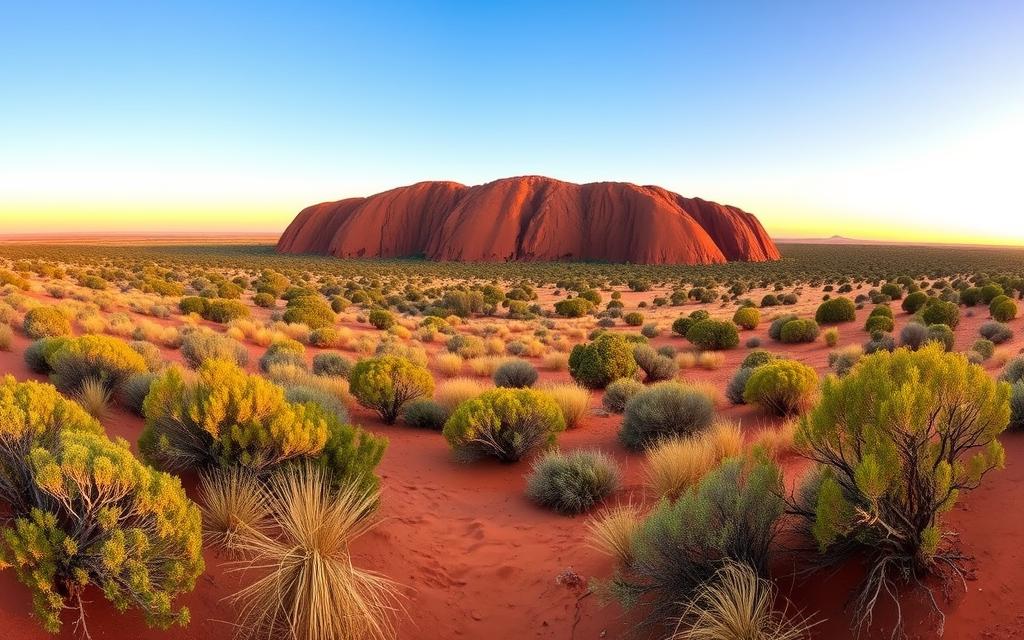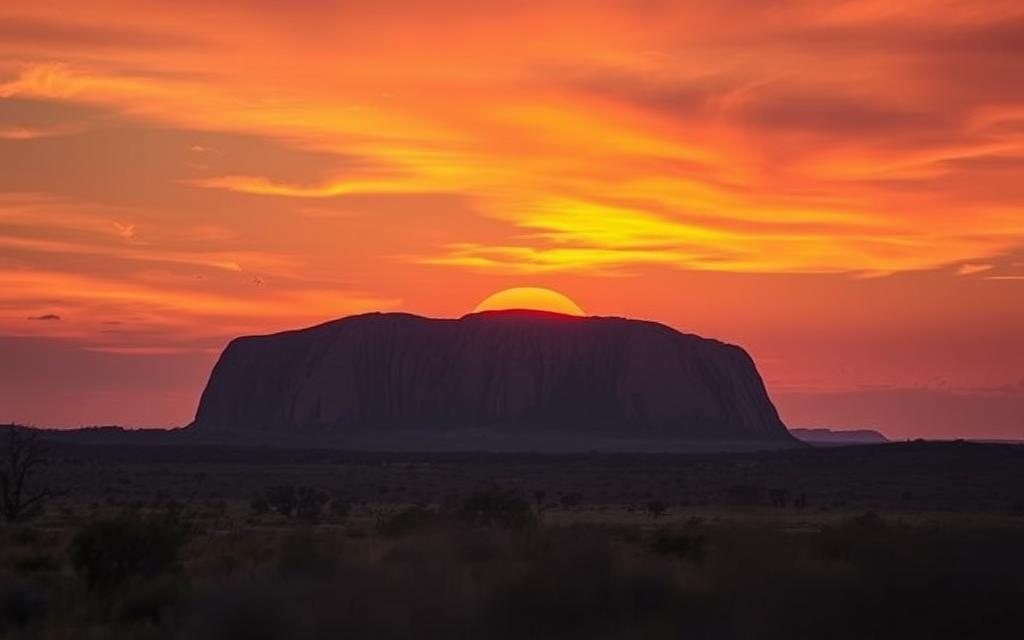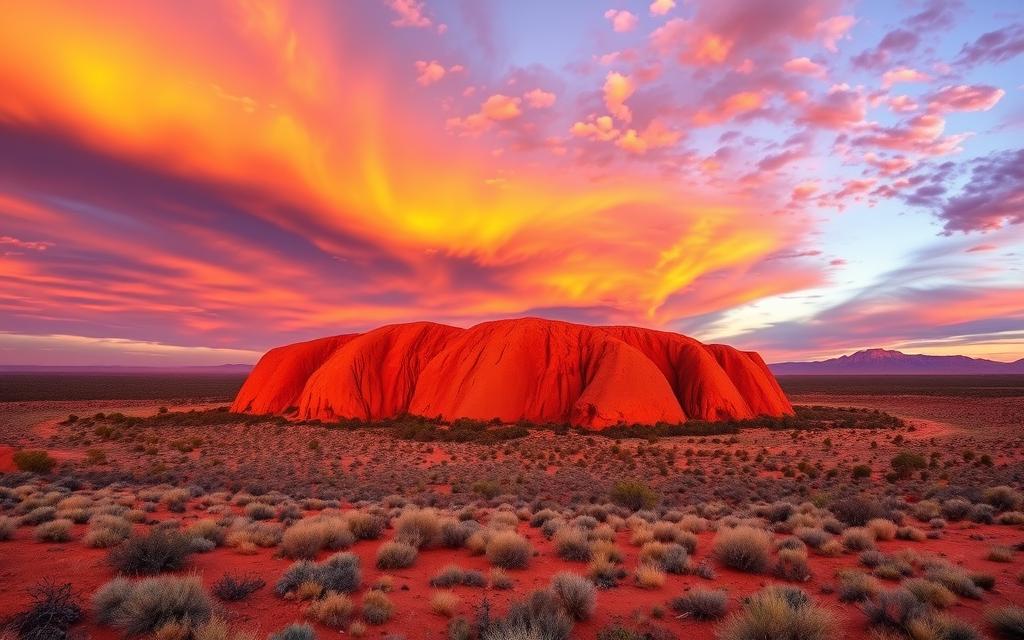What draws people to Uluru, the massive red sandstone formation in Australia’s outback? Is it the rock’s size and beauty, or its deep cultural meaning to the Anangu people? Exploring the Red Centre reveals the many reasons Uluru is a standout landmark in Australia.
Standing 348 meters tall and 9.4 kilometers around, Uluru is a natural wonder. It’s been around for about 550 million years. This rock changes colors in the desert light, drawing visitors with its beauty. But Uluru is more than a sight to see. It’s also a spiritual place for the Anangu people, who have lived here for thousands of years.
Top Tourist Attractions Uluru (Ayers Rock), Australia
Uluru, the iconic red rock monolith, is the centerpiece of the Uluru-Kata Tjuta National Park. This park is a protected UNESCO World Heritage Site covering 1,326 square kilometers. It also houses Kata Tjuta, a collection of 36 domed rock formations.
Visitors can explore the various hiking trails around Uluru. The 5.8-kilometer base walk offers stunning views of valleys, ridges, and caves. Cultural tours and experiences are also available, allowing travelers to learn about the Anangu people’s deep connection to the land.
At Kata Tjuta, the Valley of the Winds walk is a 7.4-kilometer circuit. It takes visitors into the heart of the mystical domes. The challenging Kings Canyon rim walk, with its 500-step climb, offers panoramic views of the desert landscape.
For a unique perspective, visitors can opt for scenic flights over Uluru and Kata Tjuta. These flights provide 360-degree views of the outback. The Field of Light art installation, with its 50,000 solar-powered spheres, is also a popular draw.
The Uluru-Kata Tjuta Cultural Centre and Maruku Arts offer insights into the region’s rich cultural heritage. These places allow visitors to immerse themselves in the traditions and stories of the local people.
From hiking trails and cultural experiences to scenic flights and art installations, Uluru and the surrounding Uluru-Kata Tjuta National Park offer a diverse range of Outback Adventure and Red Centre Tours. Visitors can discover the wonders of this Aboriginal Culture Experiences.
Uluru-Kata Tjuta National Park: A World Heritage Site
In the heart of Australia’s Outback lies the Uluru-Kata Tjuta National Park. It’s a UNESCO World Heritage Site, known for its natural and cultural wonders. At its core is Uluru, a massive red sandstone monolith sacred to the Anangu people for thousands of years.
Exploring Uluru: The Majestic Red Rock Monolith
Uluru, or Ayers Rock, is a sight to behold. It stands 348 meters tall and has a base of 9.4 kilometers. Visitors can explore its valleys, ridges, and caves. They can also see the rock art that covers its surface.
During rainy times, Uluru’s runoff creates waterfalls up to 100 meters high. It’s a breathtaking sight.
Kata Tjuta: The Mystical Domes of the Outback
Close by is Kata Tjuta, or The Olgas. It’s made up of 36 domed rock structures, reaching heights of 564 meters. Kata Tjuta offers a unique landscape to explore.
The Uluru-Kata Tjuta National Park is not just beautiful. It’s also deeply meaningful to the Anangu, the land’s traditional owners. Their culture, the Tjukurpa, is part of this sacred place.
Visiting Uluru or Kata Tjuta is an unforgettable experience. The park lets visitors dive into Australia’s Outback and learn about its rich Aboriginal heritage.
The Cultural Significance of Uluru for Aboriginal Australians
Uluru, the iconic red rock in Central Australia, is very important to the Anangu people. They have lived there for over 60,000 years. To them, Uluru is part of their Tjukurpa, or traditional law. They believe their creation ancestors’ actions are still seen around the rock.
The Anangu have shared their stories, songs, and traditions for generations. This keeps their connection to Uluru alive. Visitors can learn about their heritage through guided tours and educational displays at Uluru-Kata Tjuta National Park.
- The Anangu culture has been present in Central Australia for more than 60,000 years.
- Across Australia, there were over 500 Indigenous nations, speaking around 800 different dialects.
- Uluru is classified as an extremely unique geological site, formed 500 million years ago.
- The Anangu people continue to practice traditional customs and rituals that have been passed down for centuries at Uluru.
| Uluru’s Cultural Significance | Key Facts |
|---|---|
| Sacred Site | There are over 40 sacred Aboriginal sites around Uluru, with 11 Tjukurpa trails featuring the sites associated with the Dreaming stories. |
| Rock Art | Indigenous tribes in the region conserve 80 rock art sites around Uluru, featuring paintings done in natural pigments that are easily damaged. |
| Traditional Ownership | The Anangu people, belonging to the Yankunytjatjara and Pitjantjatjara tribes, were recognized as the Traditional Owners of Uluru in 1985. |
Uluru’s cultural significance to the Anangu people shows their deep connection to this sacred site. By respecting and engaging with their heritage, visitors can appreciate Uluru’s cultural importance more.
Experiencing Uluru: Walks, Tours, and Adventures
Uluru, also known as Ayers Rock, is a top spot for travelers in Australia’s Red Centre. There’s a lot to do here, from cultural tours to scenic flights. Each activity offers a unique way to see the beauty of this ancient land.
Base Walk and Cultural Tours Around Uluru
The 5.8-kilometer base walk is a favorite among visitors. It lets you see Uluru from all sides. You’ll also find ancient rock art and cultural sites along the way.
Guided tours by the Anangu people add even more to the experience. They share their deep connection to the land and traditions.
Scenic Flights and Camel Rides for Panoramic Views
Scenic flights and hot air balloon rides give you a bird’s-eye view of Uluru. They show the desert’s beauty from above. Camel rides offer a different view, letting you see Uluru’s colors change at sunrise and sunset.
Uluru has many tour options for all interests and fitness levels. This makes sure your Outback Adventure is unforgettable.

“Exploring Uluru with a knowledgeable guide was a truly transformative experience. I gained a deeper appreciation for the cultural significance of this sacred site and the resilience of the Anangu people.”
Best Time to Visit and Stay at Uluru
Uluru (Ayers Rock) is a natural wonder in Australia’s Outback. It attracts visitors from all over. The best time to visit is from May to September, when it’s cooler.
This time is perfect for exploring the Uluru-Kata Tjuta National Park. You can enjoy many activities without the heat.
Summer, from December to February, is very hot. Temperatures can hit the mid-30s Celsius. Winter, from June to September, is busier with tourists. They come to see Uluru’s colors and enjoy the cooler weather.
The best times to see Uluru are at sunrise and sunset. The rock looks amazing then. Daytime visits are also great, with tours for the best photos.
There are many places to stay, like the Ayers Rock Resort. It has different hotels and amenities. For a rustic feel, try the Ayers Rock Campground. Or, stay at Curtin Springs for a real outback experience.
“Uluru is a place that demands your full attention. It’s not something you can just glance at – it’s an experience that requires you to be fully present.”
Capturing Uluru’s Changing Colors at Sunrise and Sunset
Seeing Uluru (Ayers Rock) change colors at sunrise and sunset is amazing. The rock’s colors shift from deep reds to bright oranges, purples, and pinks. This makes Uluru a top spot for photographers and nature lovers.
Talinguru Nyakunytjaku: The Prime Viewing Platform
The Talinguru Nyakunytjaku viewing platform is the best place to see these color changes. It’s close to Uluru and offers great views of the Outback scenery. Here, you can watch the sunrise and sunset turn the landscape into a stunning Landscape Photography scene.
| Time of Day | Uluru’s Changing Colors |
|---|---|
| Sunrise | Deep reds, oranges, and purples |
| Sunset | Vibrant pinks, purples, and golden hues |
The best times to see Uluru’s colors are early morning and late afternoon. The sun’s low angle makes the Ayers Rock glow warmly. Whether you’re a pro photographer or just love nature, Talinguru Nyakunytjaku is a must-see for an unforgettable experience.

“Witnessing the colors of Uluru transform at sunrise and sunset is a truly breathtaking experience. It’s a moment of pure magic that every visitor to the Australian Outback should witness firsthand.”
Accommodation Options Near Uluru
Visitors to Uluru (Ayers Rock) and the Uluru-Kata Tjuta National Park have many places to stay. The Ayers Rock Resort offers a variety of lodging. You can choose from the Desert Gardens Hotel or the Emu Walk Apartments for a comfortable stay with modern amenities.
The Ayers Rock Campground is perfect for those wanting a traditional outback experience. It has both powered and unpowered campsites. The Curtin Springs Wayside Inn, about 100 kilometers from Uluru, also offers a unique stay. It has rooms and powered campsites, letting you experience the Australian outback.
Whether you want luxury or a rustic adventure, there’s something for everyone near Uluru. You can find the perfect place to stay, no matter your budget or preferences.
Source Links
- https://wildlifetours.com.au/blog/ayers-rock-uluru/a-travel-guide-to-australias-legendary-red-rock/
- https://www.ayersrockresort.com.au/stories/top-10-cant-miss-experiences-in-uluru
- https://northernterritory.com/uluru-and-surrounds/destinations/uluru
- https://northernterritory.com/articles/top-10-things-to-do-around-uluru
- https://www.australiantraveller.com/nt/red-centre/uluru/things-to-do-at-uluru-that-arent-climbing/
- https://whc.unesco.org/en/list/447/
- https://beyondwildplaces.com/ultimate-guide-to-uluru-kata-tjuta-national-park/
- https://ulurutoursaustralia.com.au/blog/the-significance-of-uluru-to-australian-indigenous-culture/
- https://parksaustralia.gov.au/uluru/discover/history/
- https://www.yarn.com.au/blogs/yarn-in-the-community/the-cultural-significance-of-uluru?srsltid=AfmBOooe1YQHDQyNApnSf1Hui6Gb50os_HeVfCZobRL9MLDSmApFKunb
- https://www.adventuretours.com.au/uluru
- https://www.tourradar.com/v/national-park-uluru
- https://www.ritas-outback-guide.com/uluru-tours.html
- https://ulurutoursaustralia.com.au/blog/when-is-the-best-time-to-visit-uluru/
- https://northernterritory.com/us/en/uluru-and-surrounds/destinations/uluru
- https://ulurutoursaustralia.com.au/blog/the-changing-colours-of-uluru/
- https://wildlifetours.com.au/blog/ayers-rock-uluru/sunrise-and-sunset-views/
- https://www.rebeccaandtheworld.com/uluru-accommodation-guide-where-to-stay-near-uluru/
- https://www.australiantraveller.com/nt/red-centre/uluru/uluru-accommodation-guide/

